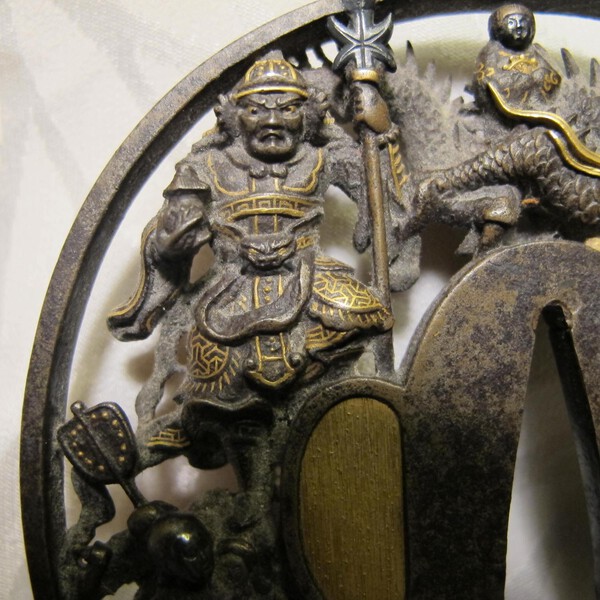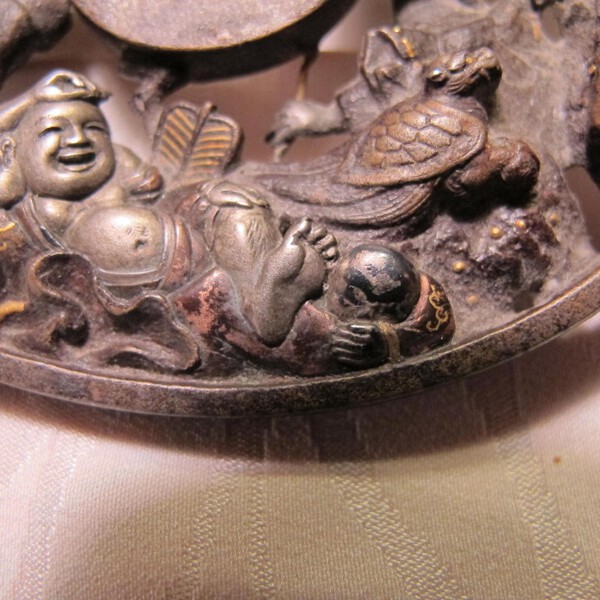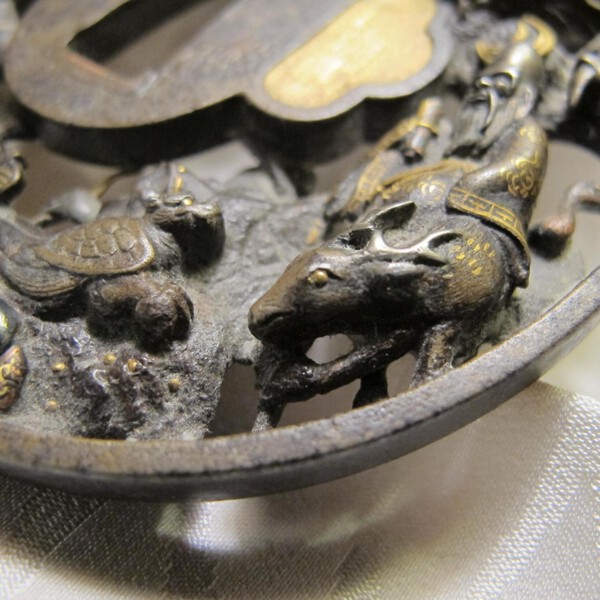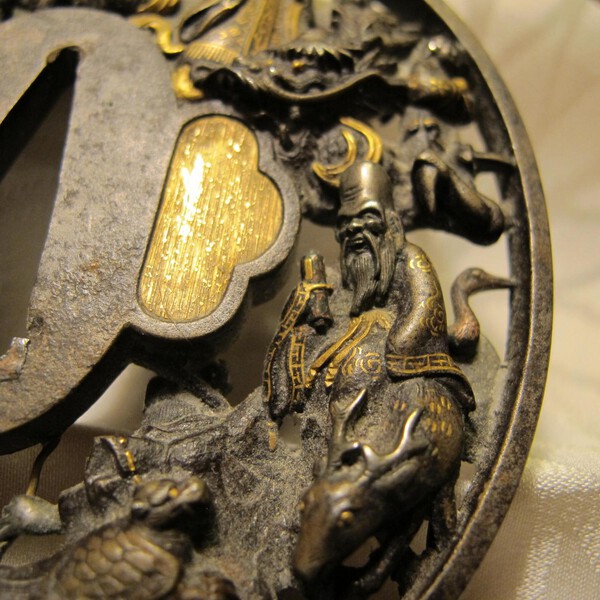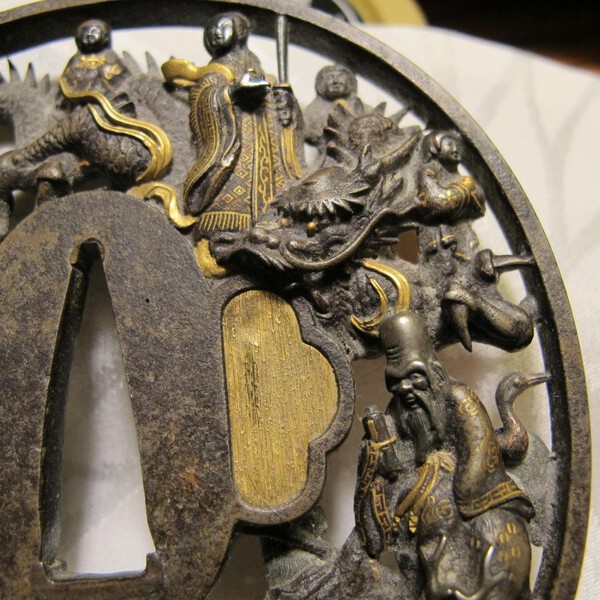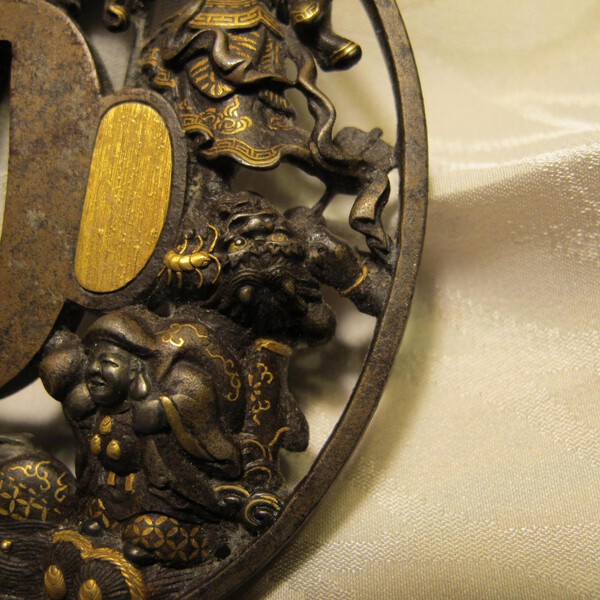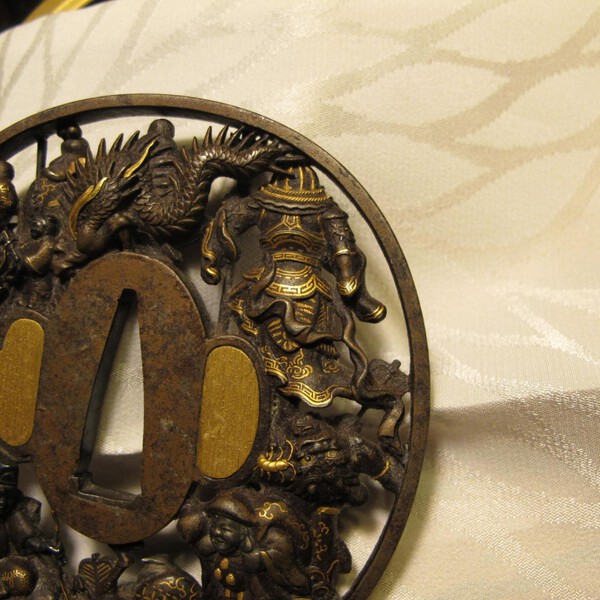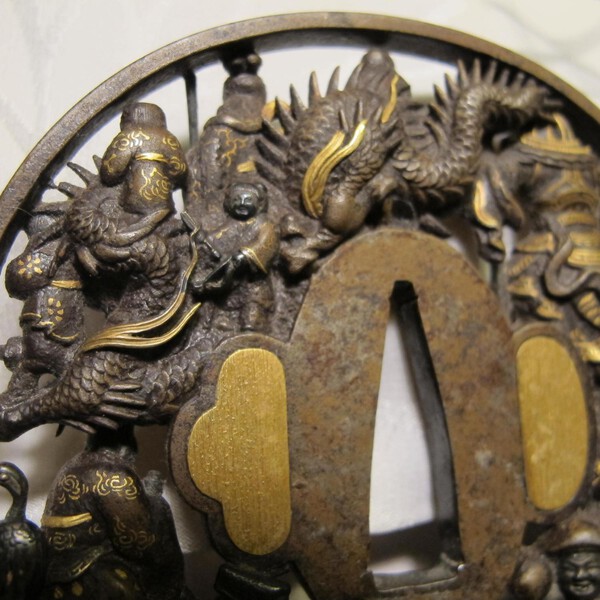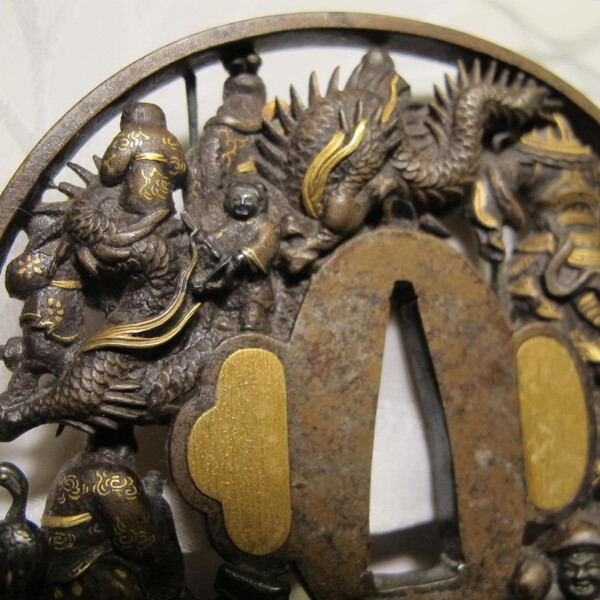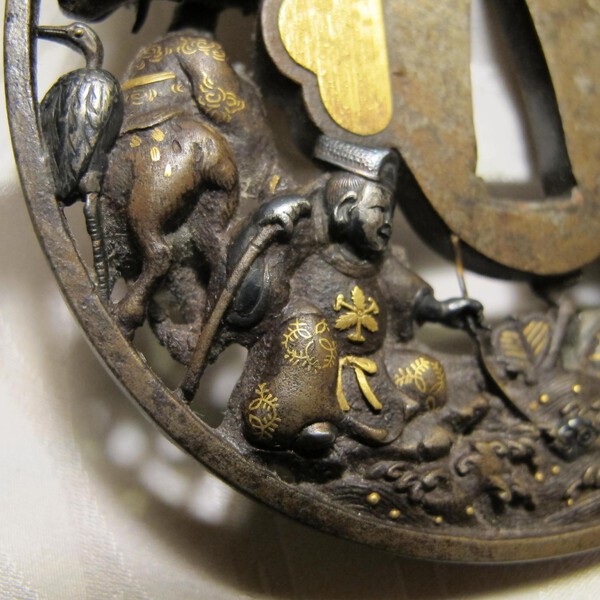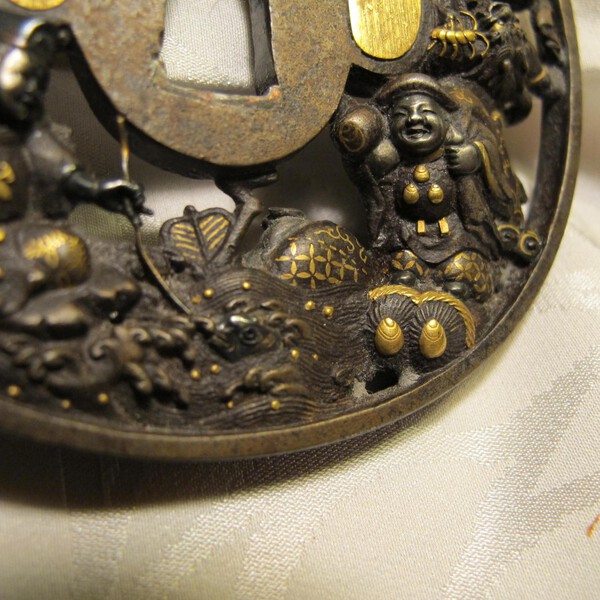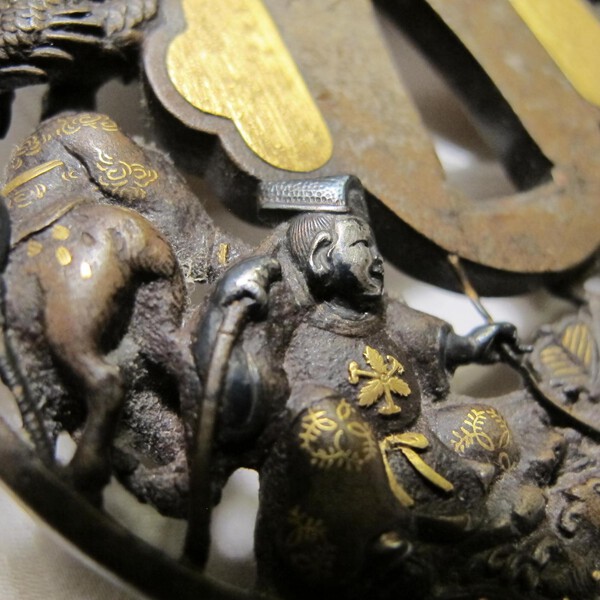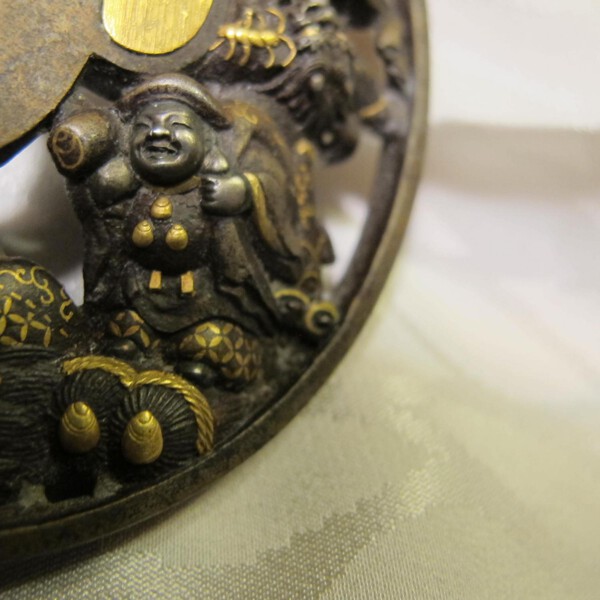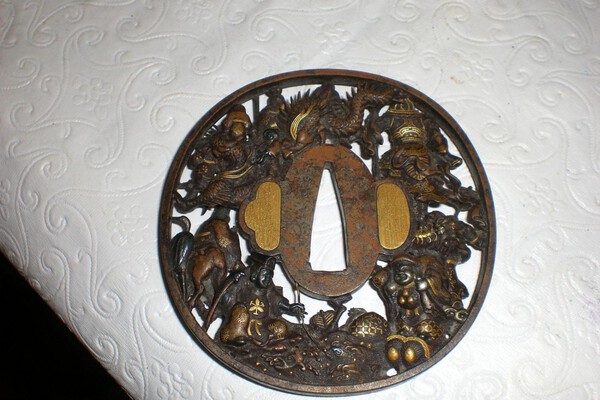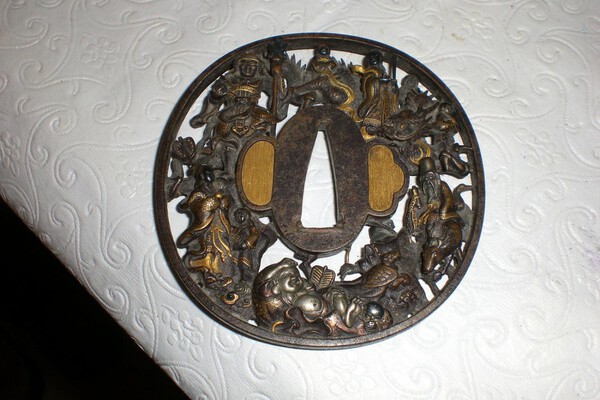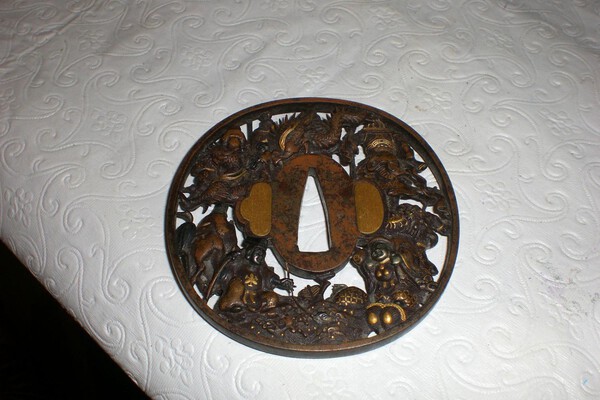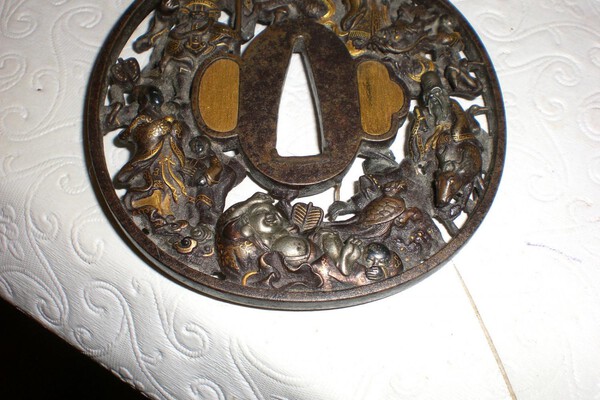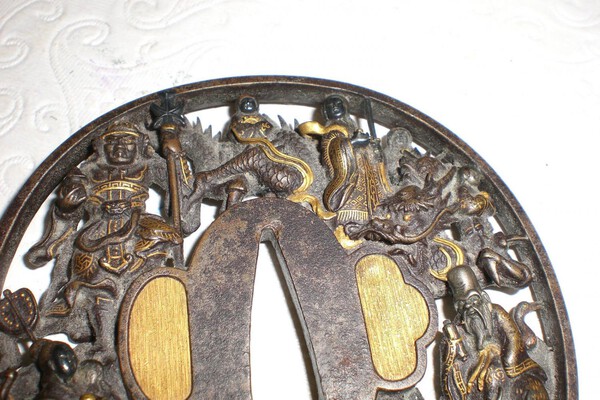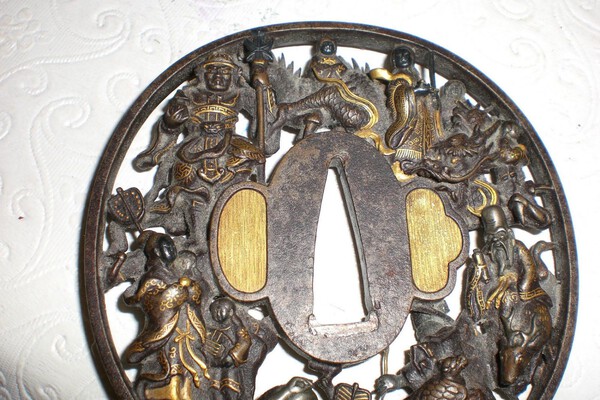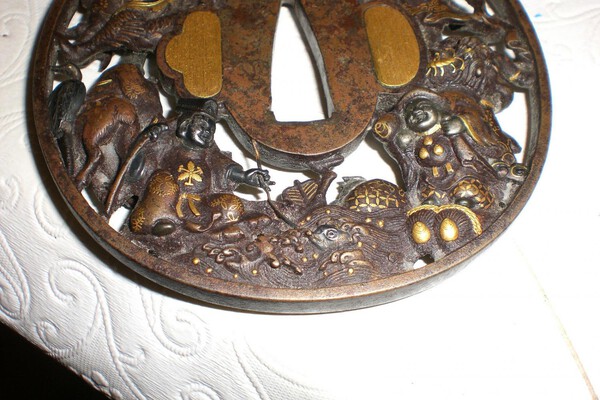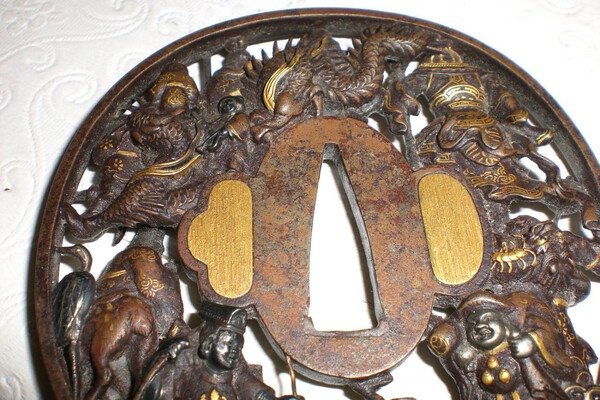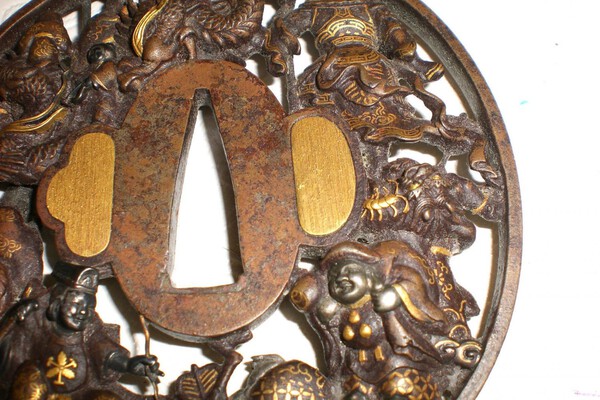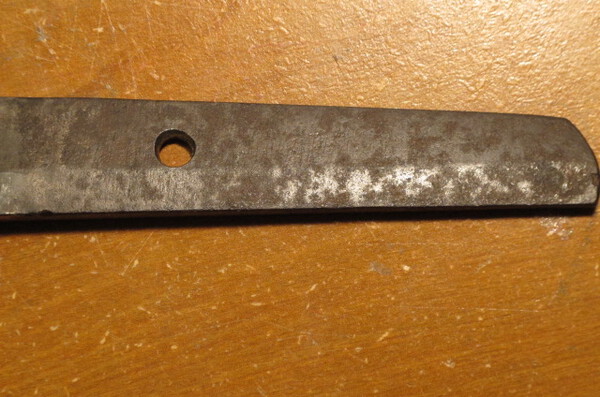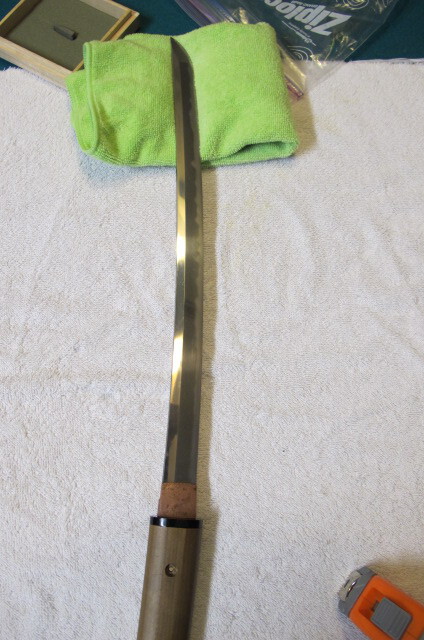-
Posts
456 -
Joined
-
Last visited
-
Days Won
3
Everything posted by ggil
-
Aye Aye Jean (about signing and profile - got it). Thanks for the compliments on the peice. Geraint, you sound like an art critic (well put!). I knew when I saw it on ebay that it was a nice piece. I wasn't wanting to spend $1000 on it, but I'm happy to have it for that , just the same. About cleaning it, I am reserved on this one. A bit too nice to mess with. Plus I don't know what Im doing. removing dirt and dust just robs protection from the awful and corroded surface underneith. Actually, the dust provides an enjoyable contrast. If i pull the dust, Ill have red flaky junk under it. If i had the umpteen hours needed to deal with what was under the dust, i'd still be in a lurch: i don't want to add oil/wax becasue I'm thinking that eventually the wax layer fails, and remaining wax becomes a water trap, and the piece dies sooner. If I had the knowledge to add an oxide layer (not the red kind), then I would clean it under magnification (very carefully), chemically add a thin oxide layer, and then maybe a wax layer. If I can't do it right, I won't mess up what is there. I can stabilize the piece by putting it into a sealed (airtight) case. Current plan is to have Tap Plastics help make me a deep, mirrored back box to hang on the wall (sit the tsuba at an angle so you can observe both sides). I can fill it with helium (from a dollar tree balloon), put in dessicant to consume the oxygen, or just let the piece eat the oxygen unitil its all gone. That is the best way for my uneducated and BUSY body to make sure the piece is preserved through my stewardship, I think. Eventually, I may have the time, and gained the knowledge to actually attempt a bit or restoration on the piece, but for now, it is better with dirt, i think. -Grant G.
-
Ian, I agree, it is a pleasure to have. I am just curious if I can get more info on it, or if someone has one which is by the same person (if the artwork is that unique or not, I have no idea). I think it may be relatively new, becasue the patina isn't black like old iron peices. Anyhow, lots going on there, and it must have really been something brand new. -Grant G.
-
Very nice tsuba, your frog and (taro leaf?) shakudo one.
-
Thanks for the well wishing and compliment. If it is cast, then my answer will come quick, becasue there will be others. Anyone ever seen this exact casting (if it is such)? I think you are referring to the fishing pole Ebisu has in his left hand. I imagine that it is mostly gold, or would have been corroded long ago (being so thin). It does kind of stick out as different than the other work (the rest is alloy guilded over iron, and therefore has exagerated depth when veiwed from the side, but this part is thin as a wire). My though is that it was original, pure gold, and is so crooked becasue it has been banged on and deformed through norman handling. I could be wrong though. I will take hig res. photos and post soon. I am risky when it comes to my nihonto buying. Fortune favors the bold, but waisting money favors the ill informed. I know hardly anything at all, but just buy with my gut, and 20/10 vision. I have been lucky, but feel that I am pressing my luck to continue buying, so had my wife change my ebay password last week (I can't logon anymore). Thanks, -Grant
-
Hello Nihonto lovers, I was wondering if anyone is willing to share thier knowledge, and tell me when and who made this bad boy. I really have no idea how old it is. The work is pretty outstanding, so I am hoping that someone has seen a signed one that is similar, or can point me in a good direction. Not interested in paying $250+ for NBTK answer, knowing that some of you are knowledgable and kind enough to help me for free. These are the ebay photos. I found it on ebay from an estate reseller in Florida. They listed it a Soten style, but I don't know if soten or another school, or some talented nobody. It is iron with inlayed alloys and guilding. The patina has some active rust around the nakago ana, which i tried to wipe off with a napkin soaked in rubbing alcohol (some came off too!). Not planning on further cleaning or adding any oil or anything (I don't want to hurt it in any way - worried that oil layer will become a pourous water trap after a long time without re-application - after I'm gone). I imagine it came over in the war, and was handled for 50 years by someone who didn't think about it's longevity, and that is why the active rust. I paid a grand for it, so it is my most expensive piece of Japanese art thus far. As always, this unknowledgable puke thanks you for your efforts and time. Thanks, -Grant
-
We are missing pictures. -Grant
-

JTK origami help and Soten tsuba mei help (plus pictures!)
ggil replied to ggil's topic in Translation Assistance
Its about time I thanked everyone for the responses. You people are so nice to share your hard earned knowledge. I have info about the tsuba with geometric inlay. It looks like late sendai school (?or style?) maybe circa early to mid 1800s. Please see attached pictures from an old haynes catalog. -
Toothpicks can grab ahold of rust and wear/lap down details on soft alloys like tsuba inlays of copper, silver, and gold alloys. Maybe that is why some more knowledgable restorers use bone because it may be less likely to trap rust as it cleans. Museums use scalpels under microscope. For the sword, a toothpick may slightly degrade mei characteristics in the same manner as it would shakudo. The art restoration game is a tricky one. Even if cleaning makes the piece overall more enjoyable, and may preserve the piece longer (as active rust removed and a fresh layer of wax added to prevent oxidation), is it worth it to remove original detail? Since I had an incident cleaning a Soten style tsuba, I have become very cautious cleaning any antique art. I still would try and remove active rust & old oil, while finishing with a layer of wax, but would avoid removing detail. A Toothbrush may be your best bet as it is safer. All comments thus far are spot on, but I just wanted to get more details to you, and save you the pain I felt over my incident. -Grant
-
For what it is worth, the person who bought the sword back in 08 was named Peter Chevis, who was a known collector. the person who sold me the sword could only state that he got it from an estate sale. Mr Chevis passed away in Nov 2012. I am thinking about asking his survivors if they know anything about the blade. The reason I know who bought it in 08 is that Mr. Tekaya is anal enough about his nohonto sales to provide paperwork with his auctions. It is at least a bit uplifting to know that a known collector thought enough of the blade to give $2000 for it, but then again he was rich, so it may not really say anything. Another side note, a collector/artist/writer from this forum is interested in the acquiring my blade at present, for photo-ing the tang (for his book of tang/filing methods. He wants to acquire the blade as assumed gimei though, which I guess makes sense. I didn't know that Bungo tangs are rare at all. I hear they are rare because most collectors see only utilitarian value in them, and there are more mino & bizen blades out there (thanks Jean).
-
Thank you Matt, I will definitely follow the good advice and practice. I really appreciate any effort in locating tracings for me. If your in the Bay area and need help with electrical, autos, PC's, or automation I can return the favor for your efforts. I know I have no idea what I am getting into making Koshirae but I have made a few pieces of decent art in the past and I feel this medium is the ultimate one period. -Grant
-
Chris and others, Thanks for the kind words of encouragement. I am actually planning on building the koshirae myself. I am crafty with woodworking and there are resources for learning tsukamaki. Antique fittings can be found for cheap on evilbay. I found a beautiful old signed Tsuba for $90 (please see my other post for a pic of the abalone tsuba viewtopic.php?f=16&t=17943). Menuki, Fuchi, Kashira are the real trouble (expensive for decent quality antiques). I think I can put nice fitting sets together with stingrey pelt and real Japanese silk ito for $1000 with all the work done myself (granted it may take a few years for me to learn to get things right). Knowing that I plan to do the work myself, are there any other suggestions that anyone would like to make? Going to all the trouble of trying to learn and art form should not be attempted lightly, so I would rather know what blade I am working with. I will research the lines of smiths that Jussi has kindly given me. The Koshirae work will not be started any time soon as other more practical projects take precedence now. Someday I may be able to contribute to this forum with some nice pictures of an adventure in making sword furniture. Back to the point, the consensus is currently (as always when non-papered): gimei shinshinto. The reason for assuming newer rather than koto is the tang rust not being as severe as it should for older blades along with the small difference in thickness from below to above the hibaki indicating less polishings. That along with the lack of flaws indicates newer than 16th century. Thanks, -Grant
-
To Adam, I was not planning on selling it, but thinking about how much to spend of fittings if I chose to get a koshirae. If the blade is near 500 years old and made with multiple carbon content steel pieces, then I think it would be worth getting matching antique fittings but if it is a gimei shinshinto made in Maru fashion, then I would not want to put any money into it. Maybe I will wait till August and take it to the SF NTHK shinsa and see what they think about it. I just would rather make a smart decision and not waste $275 only to find out that it is gimei. For $1000 I could have got something NBTHK NTHK papered, but I guess that is a lesson learned. At least the sword has served to spark my curiosity. Thanks for the response, -Grant
-
Thanks for looking Jussi, along with the information. -Grant
-
I have it on good authority (person will remain unnamed) that 'JTK' is a sham kantei. I mean that they have/are purposefully working with eBay, and other on-line, non-reputable sellers to pass off gimei 1/2 rate blades as art blades. This/my blade was sold by Mitsuhiro Tekaya in 2008 along with the "JTK" origami. Mr. Tekaya was a NHM member at one point under the name FWIC2803 and has sold JUYO nihonto. (EDIT: removed the part about the sori because I was measuring it incorrectly). I have noticed that some people think that small school maker signed blades would be less likely to be gimei, but I am curious if mine has an authentic signature or not. Even the small schools had smiths that were highly respected (worthy of faking) in their day I think. I have no easy access to examples of signatures save 1 that is totally different, but there were multiple Tekada Fusamori smiths apparently. When I bought it on evilbay a few months ago the seller listed it as 18th century hira-zukuri (hello! its traditional style) and then had a link with the photos from the 2008 sale which showed a post-it note in the corner of a photo with Tekada no Fusamori written on it. I found the sale on worthpoint and another website which showed the sale amount as $1995. When I was able to get it for $640 shipped, I thought I got a 16th century piece for a great price, but now am wondering if I simply got another old Japanese gimei weapon with little art value. approximate measurements of the blade: Thickness at the widest point at top of tang: .63cm Thickness directly above the hibaki: .58cm edge length: 43cm tang length from the edge notch: 13cm overall blade length: 57.5cm I know some of you nihonto lovers out there have access to signatures and may be able to confirm the status of my blade by the signature alone. I tried to look very closely at the blade and see if it is multi-part construction (the edge should be a laminated layer of higher grade steel in art nihonto I think) but I have never seen another nihonto so I feel like my opinion is not that useful to anyone so gracious as to be taking time to help me. I will say that the hibaki is nice and tight with a small bit of non-copper welded into the leading edge to support the blade from the ha-machi along with the mune-machi. The shirisaya seems custom made to the blade and the tang fits very tightly. The blade seems to my completely untrained eyes to be well preserved and it is razor sharp (you cannot see ANY light reflecting off the edge with it facing bright light). The point is very sharply defined and the hamon turns back at the point. The person writing the "JTK origami" wrote that the blade was made from 1532-1555 (http://nihontoclub.com/smiths/FUS6). For additional photos please see my original posting in the translation request section (viewtopic.php?f=15&t=17848) I know that the moderators, top contributes of this board, and my mentor who informed me about JTK, are like-minded in that they would like me to get the knowledge to be able to tell for myself what this blade is but I confess my impatience. If it is any consolation, I have just purchased 2 books about nihonto and can't wait to read them. In the meantime if anyone would like to give me their opinion about my sword then I would be grateful, humble, and will likely learn more through listening. My thanks goes to all those knowledgeable and enthusiastic nihonto lovers who have been so helpful, -Grant
-

JTK origami help and Soten tsuba mei help (plus pictures!)
ggil replied to ggil's topic in Translation Assistance
I just wanted to express my thanks in advance for a person's time in helping me translate the Kanji. I hope everyone enjoys the pictures. I wish I would have taken one of the wak with the handle removed, but I didn't think about it the other day and I am hesitant to handle the sword too much. The blade is very elegant looking and is most beautiful without the handle on. Some additional information:(the following was from a 2008 ebay sale of this blade from Mitsuhiro Takaya) -Grant G. http://www.worthpoint.com/worthopedia/j ... school-jtk Paper(Certificate) JTK(Juho Token Kenkyukai) Kanteisho. Signature Front:Takada Fusamori Back:No Signature. Registration(Torokusho) The Japanese sword is registered in the Agency for Cultural Affairs as artwork. The sword having a registration card is made with the Japanese traditional hand forged blade. Registration Date : February 5, 1970 The place that was discovered : Tokyo A production period Muromachi period, 16th Century. Jitetsu(Jigane) Itame Hada and utsuri and chikei in jitetsu. Very good Jitetsu. Hamon(Temper line) gunome midare, Nie-deki. Kinsuji, Sunagashi. It is very good Temper line. Blade length(Cutting edge) 43.6cm Sori 1.0cm Motohaba 27.4mm Motokasane 6.3mm Boshi Komaru polish The blade is old polished. Condition Good condition, No Chips, No Hagire, No Shinae, No bend, No other fatal damage. -

JTK origami help and Soten tsuba mei help (plus pictures!)
ggil replied to ggil's topic in Translation Assistance
-
Hello everybody and thank you for your time, I bought an old wakizashi and have been learning a bit about nihonto. The blade came with some paperwork which I was hoping to be able to get some info from. From what I can find out the paperwork was done by a polisher in Japan who also writes origami. I realize that the person appraising the sword is not highly respected as the other groups and people appraising swords such as NBTHK or NTKH, but I still feel there is some value in the paperwork. I am pretty sure the appraiser felt the sword was made by (or in part by) Fusamori from Bungo who made swords from 1532-1555 and has a Hawley rating of 15. I am hoping there are more details the appraiser wrote about the sword that would be interesting. I also bought 2 Tsuba and was hoping for any info about them. One is Soten style with mei on both sides and the other one has a nice patterned inlay. If anyone could translate the mei for the soten style then that would be great. In case anyone cares, I paid $640 for the nihonto, $550 for the soten tsuba, and $255 for the other tsuba. Thanks very much, -Grant G.


